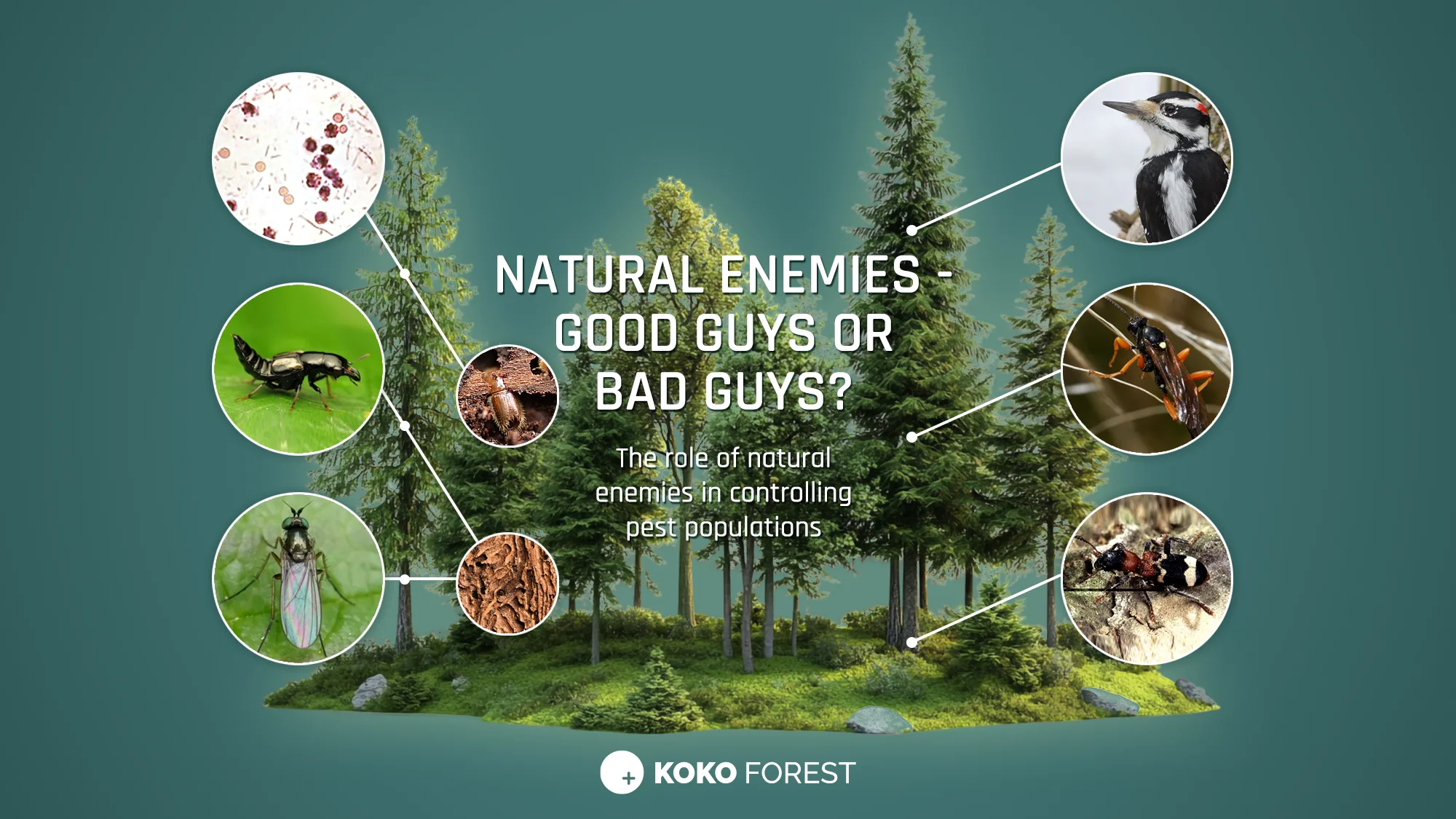NATURAL ENEMIES – GOOD GUYS OR BAD GUYS?
The role of natural enemies in controlling pest populations
Natural enemies such as predators, parasites, and pathogens are important regulators of pest populations in forest ecosystems. They help maintain forest health by controlling the number of economically harmful insects and balancing the ecosystem.
The natural enemies of various insect pests can significantly impact their populations. For example, the pupae in the cocoon stage of the common pine sawfly (Diprion pini L.) are nourishment for a variety of natural enemies such as parasitic insects and small mammals. The European spruce bark beetle (Ips typographus L.) is also attacked by several natural enemies such as predators, birds, and parasites:
Woodpeckers eat the beetle’s larvae and adults, but their impact may be limited as the abundance of these birds is not always synchronised with the mass emergence of the beetle.
Medetera flies are efficient predators whose larvae prey on developing bark beetles in their galleries.
The ant beetle (Thanasimus formicarius) is a generalist predator that preys on beetle larvae and it lives particularly in forests with high biodiversity. It is generally considered to be an important predator of the European spruce bark beetle. However, their numbers are not increasing as rapidly as those of the prey.
Other predatory beetles, such as the rove beetles (Staphylinidae), are also common generalist predators that live in the larval galleries of bark beetles.
Ichneumonid wasps (parasitic wasps) lay their eggs on or inside insect pests. The wasp develops inside the host insect, with their developing larvae eventually killing the host. The family is very species-rich.
Pathogens can infect and kill bark beetles and other pests and act as biological control agents.

The importance of natural enemies in controlling pest populations can be significant.
Impact of habitat on the effectiveness of natural enemies
Natural enemies are linked to forest diversity. Abundant understory vegetation, tree species diversity, and abundant decaying wood provide habitats and food for many predators and parasites. For example, many predatory beetles benefit from decaying wood with alternative food resources, so its preservation in the forest is essential to support their populations. As a result, forests have a higher resistance to pests.
Climate change may also affect the interactions between natural enemies and pests. For example, bird nesting may be delayed relative to pest swarming, which may reduce birds’ influence in controlling pests. The reproduction of natural enemies can be considered a delayed density-dependent response, which means that it is delayed and dependent on the population density of the host species.
Supporting natural enemies in forest management
- Leaving dead wood in the forest supports many natural enemies of insect pests.
- Maintaining tree diversity helps maintain habitats suitable for predators and parasites. Increasing the number of deciduous trees, in particular, supports diversity.
- Maintaining mature trees supports habitats for birds and other natural enemies.
- Biological control methods, such as viruses, can be an effective way to manage pest populations. For example, introducing a virus disease into forests may be considered in the European pine sawfly’s extensive stands. This virus also occurs naturally. Planned biological control will only be used in exceptional circumstances.
Sustainable forest management and support for biodiversity are key to exploiting natural enemies as part of sustainable forest management — after all, natural enemies truly are the ‘good guys’.
References:
Blomqvist M., Lyytikäinen-Saarenmaa P., Kantola T., Kosunen M., Talvitie M., Holopainen M. 2016. Impacts of natural enemies and stand characteristics on cocoon mortality of the pine sawfly Diprion pini in a Fennoscandian boreal forest. Silva Fennica vol. 50 no. 5 article id 1615.
Natural enemies may prevent damage by spruce bark beetle – researcher explains how. An article in Forest News. 2023. [Cited on 7.5.2025]. https://forest.fi/article/natural-enemies-may-prevent-damage-by-spruce-bark-beetle-researcher-explains-how/
Staab, M., & Schuldt, A. 2020. The influence of tree diversity on natural enemies—a review of the “enemies” hypothesis in forests. Current Forestry Reports, 6, 243-259.
Wegensteiner, R., Wermelinger, B., & Herrmann, M. 2015. Natural enemies of bark beetles: predators, parasitoids, pathogens, and nematodes. In Bark beetles (pp. 247-304). Academic Press.
